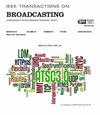No-Reference Point Cloud Quality Assessment Through Structure Sampling and Clustering Based on Graph
IF 4.8
1区 计算机科学
Q2 ENGINEERING, ELECTRICAL & ELECTRONIC
引用次数: 0
Abstract
As a popular multimedia representation, 3D Point Clouds (PC) inevitably encounter distortion during their acquisition, processing, coding, and transmission, resulting in visual quality degradation. Therefore, it is critical to propose a Point Cloud Quality Assessment (PCQA) method to perceive the visual quality of PC. In this paper, we propose a no-reference PCQA method through structure sampling and clustering based on graph, which consists of two-stage pre-processing, quality feature extraction, attention-based feature fusion, and feature regression. For pre-processing, considering the Human Visual System (HVS) tendency to perceive distortions in both the global structure and local details of PCs, a two-stage sampling strategy is introduced. Specifically, to adapt to the irregular structure of PCs, it introduces structural key point sampling and local cluster to capture both global and local information, respectively, thereby facilitating more effective learning of distortion features. Then, in quality feature extraction, two modules are designed based on the two-stage pre-processing results (i.e., Global Feature Extraction (GFE) and Local Feature Extraction (LFE)) to respectively extract global and local quality features. Additionally, for attention-based feature fusion, a Unified Feature Integrator (UFI) module is proposed. This module enhances quality perception capability by integrating global features and individual local quality features and introduces the Transformer to interact with the integrated quality features. Finally, feature regression is conducted to map the final features into the quality score. The performance of the proposed method is tested on four publicly available databases, and the experimental results show that the proposed method is superior compared with existing state-of-the-art no-reference PCQA methods in most cases.基于图的结构采样聚类无参考点云质量评价
作为一种流行的多媒体表现形式,三维点云在其获取、处理、编码和传输过程中不可避免地会遇到失真,从而导致视觉质量下降。因此,提出一种点云质量评估(PCQA)方法来感知点云的视觉质量至关重要。本文提出了一种基于图的结构采样聚类的无参考PCQA方法,该方法由两阶段预处理、质量特征提取、基于注意力的特征融合和特征回归组成。在预处理方面,考虑到人类视觉系统(HVS)倾向于感知pc的全局结构和局部细节的扭曲,引入了一种两阶段采样策略。具体来说,为了适应pc机的不规则结构,引入了结构关键点采样和局部聚类,分别捕获全局和局部信息,从而更有效地学习畸变特征。然后,在质量特征提取方面,基于两阶段预处理结果设计了Global feature extraction (GFE)和Local feature extraction (LFE)两个模块,分别提取全局和局部质量特征。此外,针对基于注意力的特征融合,提出了统一特征集成(UFI)模块。该模块通过集成全局特征和单个局部质量特征来增强质量感知能力,并引入Transformer与集成质量特征进行交互。最后,进行特征回归,将最终的特征映射到质量分数中。在4个公开的数据库上测试了该方法的性能,实验结果表明,在大多数情况下,该方法优于现有的无参考PCQA方法。
本文章由计算机程序翻译,如有差异,请以英文原文为准。
求助全文
约1分钟内获得全文
求助全文
来源期刊

IEEE Transactions on Broadcasting
工程技术-电信学
CiteScore
9.40
自引率
31.10%
发文量
79
审稿时长
6-12 weeks
期刊介绍:
The Society’s Field of Interest is “Devices, equipment, techniques and systems related to broadcast technology, including the production, distribution, transmission, and propagation aspects.” In addition to this formal FOI statement, which is used to provide guidance to the Publications Committee in the selection of content, the AdCom has further resolved that “broadcast systems includes all aspects of transmission, propagation, and reception.”
 求助内容:
求助内容: 应助结果提醒方式:
应助结果提醒方式:


